 |
|
Hong Kong professor Jim Chi Yung's experimental rooftop garden. |
As Hong Kong struggles to build an environmentally friendly city, one professor is studying ways to help cut carbon emissions and lower electricity usage by covering the city's rooftops with plants.
Jim Chi Yung, a geography professor at the University of Hong Kong, set up his first green roof in 2006 on top of one of the buildings at the university. He wanted to research how plants and grass covering a roof affect heating and cooling.
Variety of plants
The roof was divided into four parcels: one is bare concrete, and three others are covered with different plants. The first is grass, the second, a perennial that produces yellow flowers and the third, a shrub.
"So far I have been able to figure out quite a significant difference between the three vegetation type in terms of ecological and environmental benefits," Jim said.
Using infrared sensors between the plant layer and the roof, Jim found that the planted areas lowered the roof's surface temperature by as much as 26 degrees Celsius.
Bare roofs can reach temperatures as high as 50 degrees on a hot summer day because of all the solar radiation they take in, while planted surfaces stay closer to air temperature. In the winter, Jim found, the planted area helps the roof below stay warmer.
For building owners this means the top floors of a building remain cooler in the summer and warmer in the winter so less money is spent on heating and cooling.
More research
The professor's study is expanding. He has covered the university's library roof with plants, and he is researching what plants can best endure the intense sunlight in Hong Kong, and can grow in a thin layer of soil.
His plan is to develop a lightweight green roof for the city's old neighborhoods. The older buildings in those areas cannot handle a lot of extra weight on their roofs.
Construction and energy experts say many cities in warm climates, such as Hong Kong, never included insulation and other conservation measures to reduce electricity use.
Green plan
John Herbert is an energy scientist and director of Kelcroft, an environmental consulting company in Hong Kong. He says rapidly developing countries such as China and India can reduce their energy use significantly by avoiding mistakes made in other cities.
"India and developing countries in general should really, instead of just plowing ahead, they should really look at the mistakes the West has made in the building sector and not repeat them," Herbert said. "And it's easy not to repeat them because the evidence is here all around us."
The green roofing industry is well established in Europe, Germany in particular, and in Asian countries such as Singapore and Japan. North America is also catching on.
Studies throughout the world show similar results to Professor Jim's. While the temperature reductions vary, all indicate that plants act as added insulation, reducing a building's energy demand. Studies show that can mean savings of 25 percent in cooling costs.
Pros and cons
Roof gardens also can reduce storm water run-off and help combat the urban heat island effect. That is caused by heat bouncing off concrete and steel, running engines and machinery and pollution. City temperatures can be up to three degrees higher than in rural areas.
Despite the benefits of green roofs demand in Hong Kong remains relatively low.
People fear that loading roofs with plants will lead to leaks, cracks, mosquitoes and other pests. They also fear the construction cost and maintenance fees.
So far, the push to create green roofs in Hong Kong is a voluntary, non-profit effort that gets little attention.
Will others follow?
Jim says the government needs to do more.
"What I describe as psychological barriers which could be easily overcome by providing people with the right kind of information and knowledge," Jim said. "We should tell the world a compact city can be built in an environmentally friendly as well as sustainable manner."
Jim hopes that the green roof effort in Hong Kong eventually will follow in Singapore's footsteps - with roof gardens producing fresh vegetables and fruit.
(来源:VOA 编辑:蔡姗姗)
